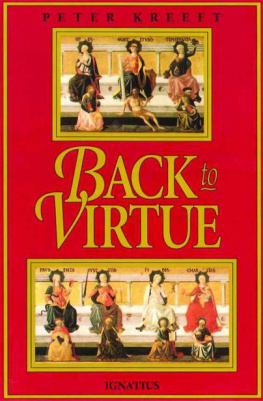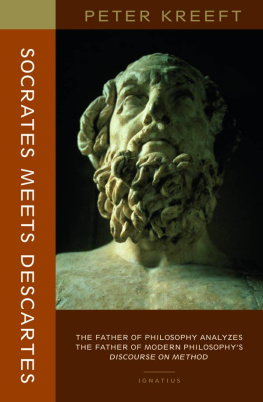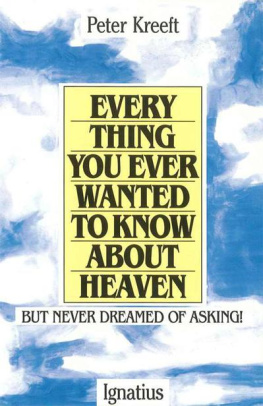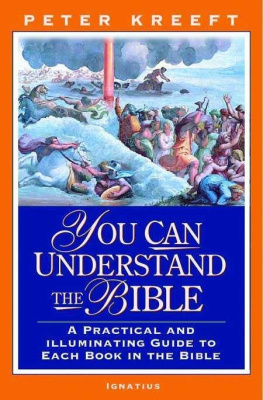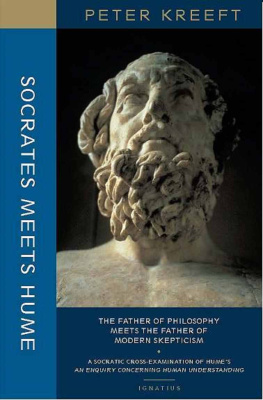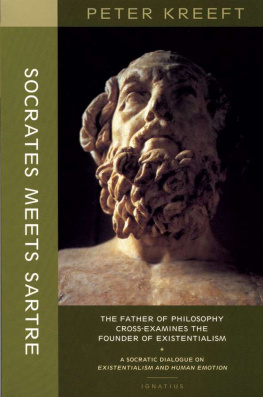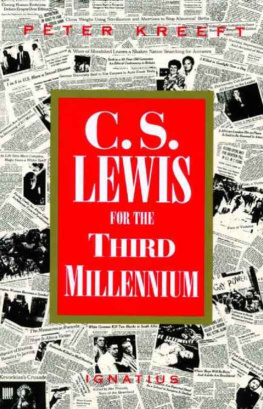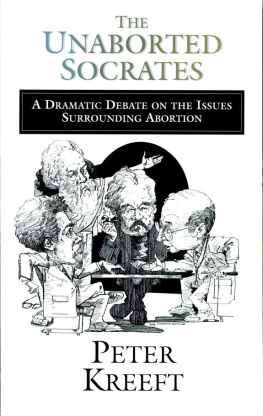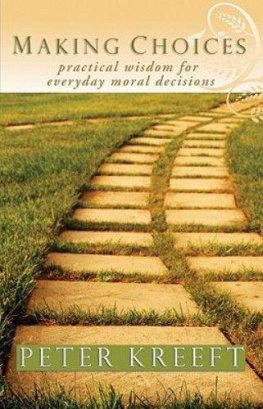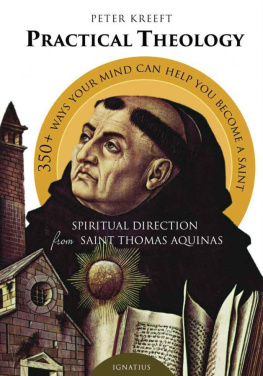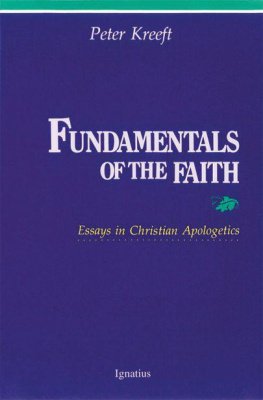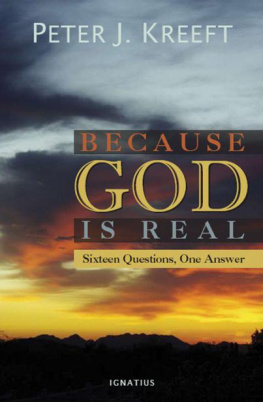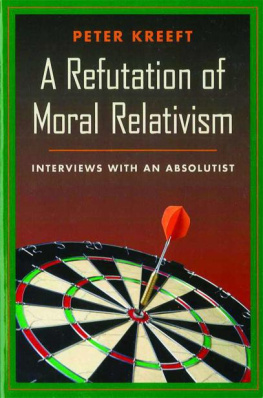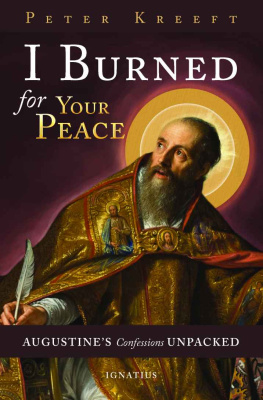BACK TO VIRTUE
PETER KREEFT
BACK TO VIRTUE
Traditional Moral Wisdom For Modern Moral Confusion
FOREWORD BY RUSSELL KIRK
IGNATIUS PRESS SAN FRANCISCO
Originally published as
For Heavens Sake
by Thomas Nelson, Inc.
Nashville Tennessee
1986 Peter Kreeft
Cover art: The Seven Virtues ,
by Francesco Pesellino (ca. 1450).
Collection of the Birmingham Museum of Art:
Gift of the Samuel H. Kress Foundation
Cover design by Riz Boncan Marsella
Published 1992 Ignatius Press, San Francisco
1992 Peter Kreeft
All rights reserved
ISBN 0-89870-422-7
Library of Congress catalogue number 92-72114
Printed in the United States of America
For Edna
who already knows this
because she knows Him
virtue (n.) 1. Moral excellence; right living; goodness. 2. A particular type of moral excellence. 3. A good quality or feature. 4. Purity, chastity. 5. Effectiveness.
Virtue comes from the Latin word virtus , which meant manliness , or virility. Thus, as one wag notes, the word which used to mean a mans ability to impregnate a woman (meaning 5) came to mean a womans ability not to be impregnated by a man (meaning 4).
CONTENTS
I
Missing: A Virtuous People
1. A Civilization at Risk:
Whatever Became of Virtue?
2. Western Culture on the Couch:
A Spiritual Psychoanalysis
3. Spiritual History 101:
How Did We Get to the Edge?
II
The Key: Personal Virtue
4. Justice, Wisdom, Courage, and Moderation:
The Four Cardinal Virtues
5. Faith, Hope, and Love:
The Three Theological Virtues
6. The Beatitudes Confront
the Seven Deadly Sins
FOREWORD
Can virtue be taught? That question of the fifth century before Christ looms gigantic again near the end of the twentieth century of the Christian era. Peter Kreeft, who perceives much about life and death, aspires to teach us about virtues , both classical and theological.
He does not aspire to teach us about values , praise be. As he puts it, Values are like thoughts, like ghosts, undulating blobs of psychic energy. The positivistic sociologist would reduce our moral order to personal preferences called values; Professor Kreeft has taken arms against such reductionists.
The practical aim of this book is to help in the restoration of moral habits among the rising generation. Gustave Le Bon remarks that we folk of the twentieth century may be more moralistic than were medieval people, in the sense that we fret more about morality, but men and women of the Middle Ages had better moral habits. In medieval times, the seven cardinal virtues were known to everyone, while nowadays it is a rare university student who can name the seven.
In its classical signification, virtue means, the power of anything to accomplish its specific function; a property capable of producing certain effects; strength, force, potency. Also the word virtue implies a mysterious energetic power, as in the gospel according to Mark: Jesus, immediately knowing... that virtue had gone out of him, turned him about in the press, and said, Who touched my clothes? (Mark 5:30 KJV, italics added).
Presently, virtue also signifies moral goodness; the practice of moral duties and the conformity of ones life to the moral law; uprightness; rectitude. It carries with it a strong suggestion of public leadership.
Peter Kreeft reminds us that ethics without virtue is illusion. He is moved by the Christian perception that virtue is the fruit of faith. Therefore, he does not hesitate to draw the sword of faith and then sound the horn of virtue, rallying us (in the phrases of Pico della Mirandola) to join battle as to the sound of a trumpet of war on behalf of mans higher nature, defying the vegetative and sensual errors of our age. This book, Back to Virtue , is steeped in old virtues. It exhorts us to renew them.
Russell Kirk
INTRODUCTION
Is Virtue Out of Date ?
A book about virtues and vices? How quaint and out-of-date!
I reply that a civilization with such a notion of virtues and vices will soon itself be quaint and out of date.
But life today is so confusing!
Yes, life is always confusingto someone without principles. Finding your way through downtown Boston is very confusingto out-of-towners without road maps. The most fundamental issue our civilization faces is: Are there moral road maps?
If there is a God, there is a map. If God has a map, his map is the true map.
The civilization you sit in as you read this book, the civilization that is now in obvious crisis, perhaps death pangs, twisting grotesquely like a dying animal, swirling down the garbage drainthis civilization was founded on Gods road map.
The most striking feature of this map is the stark fact of the Two Roads. There is the road that leads to Life, and there is the road that leads to Death. There is Good, and there is Evil. There is Right and there is Wrong.
Here is one of the earliest and strongest statements of this map. It comes from Moses just before he dies. It is his last word to Gods chosen people, as they are poised to enter their Promised Land; it is to be their unforgettable guidepost forever:
See, I have set before you this day life and good, death and evil. If you obey the commandments of the Lord your God which I command you this day, by loving the Lord your God and walking in his ways and by keeping his commandments and his statutes and his ordinances, then you shall live and multiply and the Lord your God will bless you.... I call heaven and earth to witness against you this day, that I have set before you life and death, blessing and curses therefore choose life, that you and your descendents may live, loving the Lord your God, obeying his voice, and cleaving to him; for that means life to you (Dt 30:15-20).
Here is another statement of the same map. It is the first Psalm, the key and gateway to all the others. The map shows us two roads. Only two.
Road #1
Blessed is the man who walks not in the counsel of the wicked
Nor stands in the way of sinners
Nor sits in the seat of scoffers.
But his delight is in the law of the Lord
And on His law he meditates day and night.
He is like a tree planted by streams of water
That yields its fruit in its season
And its leaf does not wither.
In all that he does, he prospers.
Road #2
The wicked are not so
But are like the chaff which the wind drives away.
Therefore the wicked will not stand in the judgment
Nor sinners tn the congregation of the righteous.
For the Lord knows the way of the righteous
But the way of the wicked will perish.
Here are three more statements of this vision of the Two Roads, from our centurys most powerful and influential Christian writer, C. S. Lewis:
I
We are not living in a world where all roads are radii of a circle and where all, if followed long enough, will therefore draw gradually nearer and finally meet at the centre; rather in a world where every road, after a few miles, forks into two, and each of those into two again, and at each fork you must make a decision.
... I do not think that all who choose wrong roads perish; but their rescue consists in being put back on the right road ( The Great Divorce ).
II
As there is one Face above all worlds merely to see which is irrevocable joy, so at the bottom of all worlds that face is waiting whose sight alone is the misery from which none who beholds it can recover. And though there seemed to be, and indeed were, a thousand roads by which a man could walk through the world, there was not a single one which did not lead sooner or later cither to the Beatific or the Miserific Vision ( Perelandra ).
III
There are only two kinds of people in the end: those who say to God, Thy will be done, and those to whom God says, in the end, Thy will be done ( The Great Divorce ).
Next page
